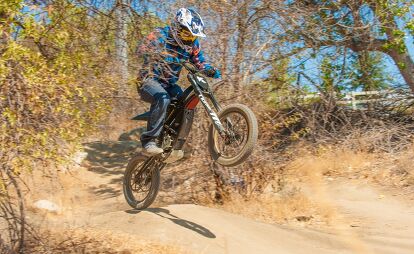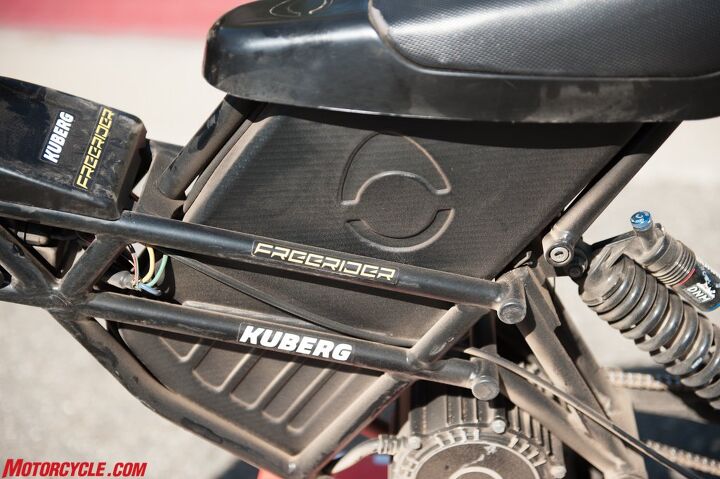Kuberg Freerider Review

Motorcycle or mountain bike? You decide
By virtue of having a motor and a tube on the right that you twist to move forward, we’re calling the Kuberg Freerider an electric motorcycle. And because it’s new and different, we also made a post about the entire line of Kuberg electric bikes, which includes three children’s models in addition to this, the adult-sized Freerider.
A funny thing happened after that post went live. The timing of it coincided with Kelly Knipe’s trip to Southern California. Knipe’s the Western Region Sales Manager for Kuberg USA, and his job, essentially, is to be the evangelist spreading the Kuberg gospel. He had a prototype Freerider with him and offered MO a chance to ride it. That’s an offer we couldn’t refuse.
First, The Details
Coming in at a purported 79 lbs, many of the Freerider’s components – like suspension, handlebars, wheels, brakes, and tires, are sourced from mountain bikes, not motorcycles, making this unlike the usual fare we test here at MO. Since we regularly cover electric motorcycles, the only thing that would seem familiar is the power unit, so let’s start there.
Housed below the seat is a 22.2 Ah lithium-ion battery, shaped like a trapezoid, delivering current to a 48-volt brushless DC motor rated at 8kW, or roughly 11 hp. Kuberg lists top speed at 34 mph, and says the Freerider can go up to an hour at full throttle. To recharge, simply plug it into your standard wall outlet. From a completely drained battery, 90 minutes will get 80% charge back, and a full two hours should get you back to 100%. Kuberg’s own proprietary motor controller meters power delivery, and though Knipe insisted that delivery is very smooth and linear, he also made it perfectly clear the Freerider I’d be testing was a prototype. One without the latest software.
All of these components are housed within a tubular steel frame. The Freerider’s MX-inspired seat sits atop, but feels more like the banana seats from your little sister’s bicycle as a kid. Apart from that, the Manitou Dorado fork (considered one of the best in the downhill mountain bike game, I’m told) handles bumps out front, and the DNM Burner RB-RCP shock keeps the back tire on the ground. Disc brakes at both ends measure 203mm, and feature sintered pads for excellent and consistent stopping power. Maxxis Creepy Crawler tires are mounted on 20-inch wire-spoke wheels.
Let’s Ride
Since the Freerider is more mountain bike than motorcycle, a question set in: where should we test it? Kuberg bills the Freerider as a bike that’s equally as comfortable in the backwoods as it is on the backstreets; whether it’s urban exploring or ripping up some single track. The original plan included a go on a kids motocross track, but that’s not exactly the right environment for the Freerider. A better plan emerged when Knipe discovered a business complex with a large field behind it. Sweetening the deal was the fact the locals had already carved out a makeshift BMX-style pump track at one corner. The field also included a sandwash, some single track, and a paved walking/jogging path for pedestrians – the perfect environment for the Freerider.
The first thing you notice with the Freerider is its weight, or lack thereof. Despite its 34.5-inch seat height, it’s a tiny little thing and truly does feel more like a beefed-up mountain bike than a motorcycle. And because it’s so narrow, touching the floor is hardly an issue. The seat itself is a little firm for my taste, and slippery, too, but when you’re standing up on the pegs to clear jumps or a set of stairs, then it doesn’t matter much.
Even with the outdated software on the prototype Freerider, acceleration is brisk. However, the biggest difference between the prototype software on the bike I was testing and the production version is the linearity of power delivery. The prototype was nearly two-stroke like in that initial throttle turn gets you nothing until – bam! – and power kicks in. The jolt of acceleration isn’t mind-blowing, but it does make throttle modulation difficult. Knipe assures me this issue has been fixed on the latest production models.
At the pump track the power delivery wasn’t such an issue, as we were generally asking for full power to get proper launches off each jump. The suspension at both ends handled the landings without any protest, and the bars gave decent leverage to maneuver the Freerider from obstacle to obstacle. If I were to nitpick, a slightly wider bar would be even better, something the aftermarket could easily fix.
What made riding the Freerider at the pumptrack even more fun was the fact we were riding during business hours, close to several businesses, and nobody even knew we were around. The locals who helped guide Knipe to the track informed us that, back in the day, the cops were routinely called over because of noise complaints from small-displacement motocrossers ripping up the track. No such issue on the e-bike.
In the sandwash, the Freerider needs momentum to plow through the sand. Depending on the amount of sand, there isn’t enough juice to push the Freerider out of it from a complete stop. However, since the bike is so small and light, you can push along with your feet until the bike gets moving under its own power again. Normally, riding through sand is an intimidating endeavor, especially for the inexperienced like myself, but the Freerider’s light weight means maneuvering it around is far less taxing on the mind, and tipovers are far less painful on the body. Make no mistake, though – the Freerider is not meant for the dunes.
What it is great at is mountain bike paths, which shouldn’t be surprising considering the amount of mountain bike components the Freerider has. Standing up on the pegs and goosing the e-throttle, the Freerider climbed its way up the singletrack path in the field with no issues. Navigating the track with the bars and weighting the pegs was a snap on such a light bike, and since the electric motor is doing all the work for you, you’re not huffing and puffing and drenched in sweat once you reach the top! On descents, a rider uses both brake levers situated on the handlebars, like a bicycle, but the front brake is on the right, like a motorcycle. Braking power is strong and controllable, but it takes some mental recalibration to use both your hands for braking.
My Kind of Mountain Bike
Kuberg says battery life can last an hour or more of full-throttle action with a 165-pound rider on board. At 150 pounds, I didn’t have the throttle to the stop for a full hour, nor did I come close to draining the battery completely. Like virtually all e-bikes these days, Kuberg has a smartphone app coming for all its bikes, including the Freerider, that lets you monitor a myriad of parameters, including battery life remaining. But since the app isn’t available yet, I don’t exactly know what state of charge the prototype Freerider was in.
Kuberg wants to show it’s potential U.S. customers that its products aren’t vaporware anymore, and in fact you can buy any of its four models right now, as the bikes are shipping from the company’s U.S. warehouse in Ohio.
So what do I make of the Freerider? In a nutshell, it’s the perfect mountain bike – not motorcycle – for me. Despite riding the prototype, the fit and finish of the Freerider looked nice and polished. It’s made to navigate paths and trails, and the fact you don’t need to pedal sweetens the deal (yeah, I’m lazy like that). As a bonus, if I want to relive the BMX days of my youth, I can do that, too.
At $4,000 for the Freerider, there are plenty of real mountain bikes that cost as much, or more – and with those you still have to pedal!
If you’re interested in the Freerider, or any of the Kuberg models, you can contact Kelly Knipe at 888-304-0624 or email him: knipe@kuberg.com.

Troy's been riding motorcycles and writing about them since 2006, getting his start at Rider Magazine. From there, he moved to Sport Rider Magazine before finally landing at Motorcycle.com in 2011. A lifelong gearhead who didn't fully immerse himself in motorcycles until his teenage years, Troy's interests have always been in technology, performance, and going fast. Naturally, racing was the perfect avenue to combine all three. Troy has been racing nearly as long as he's been riding and has competed at the AMA national level. He's also won multiple club races throughout the country, culminating in a Utah Sport Bike Association championship in 2011. He has been invited as a guest instructor for the Yamaha Champions Riding School, and when he's not out riding, he's either wrenching on bikes or watching MotoGP.
More by Troy Siahaan
















































































































Comments
Join the conversation
4k gets you a mid-level mountain bike these days, and the top mountain bikes chime in at $7-10,000, so this think is actually in an interesting price point. High enough to discourage tourists, but low enough for the big spenders to take a chance. That said, expect much grief from trail access types if people ride these on mountain bike trails, horse trails, hiking trails - users and land managers do not allow these devices on trails. Interesting times ahead, indeed.
Really well made bike. Customer service is non existent to horrible, at best. I have a Hero Cross that has been sitting in my garage for a year. I've spent hundreds on factory parts that aren't working.
Any machine, no matter how well made will break given the environment it's exposed to. Once it's broken, that's it, you're on your own. The dealers in the US are jumping ship also.
Buyer beware.